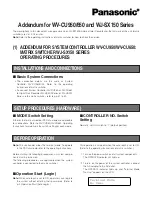
change the IPv6 DHCP Snooping settings for one or more interfaces, select each entry to modify and
click
Edit
. The same settings are applied to all selected interfaces.
To access this page, click
Switching
>
IPv6 DCHP Snooping
>
Base
>
Interface Configuration
in the
navigation menu.
Table 195: IPv6 DHCP Snooping Interface Configuration Fields
Field
Description
Interface
The interface associated with the rest of the data in the row. When configuring
the settings for one or more interfaces, this field identifies each interface that is
being configured.
Trust State
The trust state configured on the interface. The trust state is one of the following:
•
Disabled – The interface is considered to be untrusted and could potentially
be used to launch a network attack. DHCPv6 server messages are checked
against the bindings database. On untrusted ports, IPv6 DHCP snooping
enforces the following security rules:
•
DHCPv6 packets from a DHCPv6 server (ADVERTISE, REPLY, and
RECONFIGURE) are dropped.
•
RELEASE and DECLINE messages are dropped if the MAC address is in
the snooping database but the binding's interface is other than the
interface where the message was received.
•
DHCPv6 packets are dropped when the source MAC address does not
match the client hardware address if MAC Address Validation is globally
enabled.
•
Enabled – The interface is considered to be trusted and forwards DHCPv6
server messages without validation.
Log Invalid Packets
The administrative mode of invalid packet logging on the interface. When
enabled, the IPv6 DHCP snooping feature generates a log message when an
invalid packet is received and dropped by the interface.
Rate Limit (pps)
The rate limit value for DHCPv6 packets received on the interface. To prevent
DHCPv6 packets from being used as a DoS attack when IPv6 DHCP snooping is
enabled, the snooping application enforces a rate limit for DHCPv6 packets
received on untrusted interfaces. If the incoming rate of DHCPv6 packets
exceeds the value of this object during the amount of time specified for the burst
interval, the port will be shut down. You must administratively enable the port to
allow it to resume traffic forwarding.
Burst Interval (Seconds)
The burst interval value for rate limiting on this interface. If the rate limit is
unspecified, then burst interval has no meaning.
If you change any of the parameters, click
Submit
to apply the changes to the system. If you want the
switch to retain the new values across a power cycle, you must save the configuration.
Click
Refresh
to refresh the page with the most current data from the switch.
IPv6 DHCP Snooping Static Bindings
Use the IPv6 DHCP Snooping Static Bindings page to view, add, and remove static bindings in the IPv6
snooping bindings database.
Configuring Switching Information
ExtremeSwitching 200 Series: Administration Guide
198
















































